Chongqing Two Rivers Cruise is located along the river areas such as Yuzhong District, Jiangbei District and Nan'an District of Chongqing. Launched relying on the Yangtze River and the Jialing River, the two mother rivers, it is a highly representative urban tourism card of Chongqing and a core tourism project demonstrating the landscape and urban style of Chongqing. As a featured tourism product focused on by Chongqing, it connects multiple scenic spots along the rivers, including those related to several national 4A-level and 5A-level scenic areas as well as national scenic spots. The core cruising water area of the scenic spot covers the section of the Yangtze River from Chaotianmen to Jiulongpo District and the section of the Jialing River from Chaotianmen to Ciqikou. The total area of the riverfront landscape belt radiated by it is about 50 square kilometers. Its core feature lies in the perfect integration of the three-dimensional landform of the mountain city and the vivid water scenery of the river city. Tourists can take boats to enjoy the scattered modern skyscrapers, ancient historical buildings, brilliant urban night scenes and unique bridge clusters on both banks, forming a magnificent picture of "the river flows through the city and the city is reflected in the river". Nearly 20 cross-river bridges with different styles are distributed along the rivers, including landmark buildings such as the Chongqing Yangtze River Bridge and the Qiansimen Jialing River Bridge. Among them, the main bridge of the Qiansimen Jialing River Bridge is 878 meters long and 36.2 meters wide, serving both highway and rail transit purposes. The main span of the Chaotianmen Yangtze River Bridge is 552 meters, which was the arch bridge with the largest span in the world at that time. Meanwhile, well-known landmark buildings such as Hongya Cave and Chongqing Grand Theatre are also located along the rivers. With a construction area of 46,000 square meters and 11 floors, Hongya Cave is built against the mountain and has distinct traditional Bayu architectural characteristics.
Historical Culture
The historical origin of Chongqing Two Rivers Cruise stems from the profound impact of the Yangtze River and the Jialing River on the urban development of Chongqing. Chaotianmen, the confluence of the Yangtze River and the Jialing River, has been an important land and water terminal in Chongqing since the Ming and Qing Dynasties, serving as a hub for material distribution and personnel flow. At that time, merchant ships and fishing boats gathered here, gradually forming a unique dock culture, which laid the geographical and cultural foundation for the rise of the Two-River Tour later.
Since modern times, with the opening of Chongqing as a treaty port and the advancement of urban construction, various factories, warehouses and residential buildings have been built one after another in the riverside areas, and bridge construction has also been carried out sequentially. The Chongqing Yangtze River Bridge was completed and opened to traffic in 1980, becoming the first large-scale highway bridge in the upper reaches of the Yangtze River, which greatly promoted the development of transportation and tourism on both banks.
In the 1990s, Chongqing began to explore a tourism model based on the two rivers, initially launching short-distance sightseeing with small cruise ships. After 2000, with Chongqing putting forward the urban positioning of "a mountain and river city", the Two-River Tour has gradually become standardized and large-scaled, with continuous upgrading of cruise ship facilities and optimization of routes. After 2010, along with the completion of landmark buildings such as Hongya Cave and Chongqing Grand Theatre and the improvement of the night lighting project, the Two-River Tour has become a core project showcasing the charm of Chongqing's night scenery. In addition, the Two-River Tour also undertakes the function of spreading Bayu culture. The stilted buildings along the rivers, dock customs, Sichuan Opera elements and other cultural features enable tourists to deeply understand the historical heritage of Chongqing through cruise ship explanations and waterfront landscape displays. Moreover, the special events held every year, such as the cultural and tourism activities of the Yangtze River Economic Belt and the Mid-Autumn moon-gazing on the river, have further enriched the cultural connotation of the Two-River Tour.
Major Scenic Spots
Chaotianmen Square
Located at the confluence of the Jialing River and the Yangtze River on the Yuzhong Peninsula in Yuzhong District, Chaotianmen Square is the core starting point of Chongqing Two Rivers Cruise, covering an area of about 80,000 square meters. It is where the clear water of the Jialing River and the turbid water of the Yangtze River meet, forming a distinctive "Jiamashui" scene with a clear boundary between the two. A 20-meter-high landmark sculpture of Chaotianmen stands in the center of the square, symbolizing Chongqing's historical status as a land and water hub. As a time-honored landmark of Chongqing, Chaotianmen used to be the place where ancient officials received imperial edicts and court officials. Today, it is an excellent spot for tourists to overlook the confluence of the two rivers and enjoy the river scenery. It is also one of the main docks for the Two-River cruise ships, from which tourists can easily start their Two-River tour.


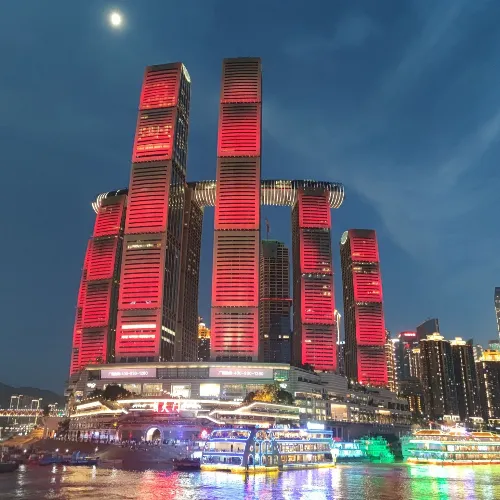
Hongya Cave Folk Customs Area
Situated on the Jialing River Riverside Road in Yuzhong District, adjacent to the Qiansimen Jialing River Bridge, Hongya Cave Folk Customs Area covers a construction area of 46,000 square meters and is one of the most visually striking landscapes during the Two-River Tour. The area is dominated by traditional Bayu stilted buildings, with 11 floors in total. The buildings are constructed in accordance with the mountain terrain, rising layer by layer, which perfectly fits the topographical characteristics of the mountain city. Hongya Cave integrates multiple functions including catering, entertainment, accommodation and sightseeing. It has a Bayu folk culture exhibition area inside, displaying the folk customs and traditional handicrafts of old Chongqing. When night falls, all the lights of Hongya Cave are turned on. The warm yellow lights outline the contour of the buildings, reflecting each other with the reflection in the Jialing River, just like the scene in the animated film "Spirited Away" in reality, and it is one of the core highlights for viewing the night scenery during the Two-River Tour.
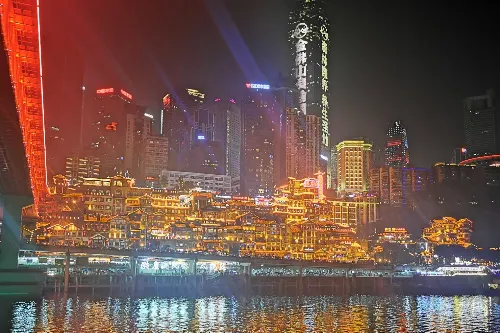
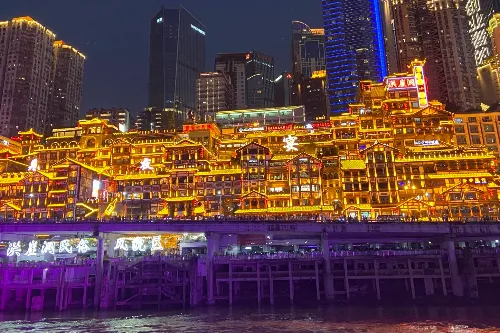
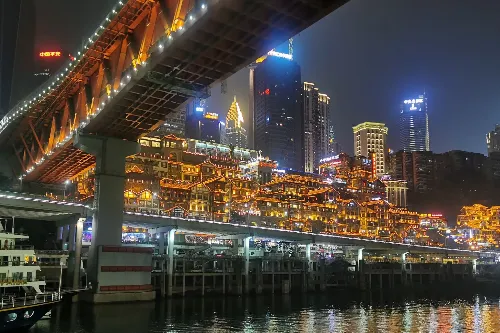
Chongqing Grand Theatre
Located on the Jiangbeizui Riverside Road in Jiangbei District, adjacent to the Jialing River, Chongqing Grand Theatre has a total construction area of 103,307 square meters and a building height of 64.8 meters. The exterior of the theatre adopts an irregular geometric design, mainly featuring light blue glass curtain walls, which looks like a giant ship ready to set sail, forming a harmonious landscape picture with the surrounding river views and bridges. As an important cultural landmark of Chongqing, the Grand Theatre has multiple functional areas inside, including a large auditorium, a medium-sized auditorium and rehearsal halls, which can accommodate nearly 3,000 audiences. It mainly hosts high-level artistic performances such as operas, dance dramas and symphonies. Viewed from the Two-River cruise ships, the modern architectural style of the Grand Theatre forms a sharp contrast with the Hongya Cave on the opposite bank. It appears simple and magnificent during the day, and more vivid under the illumination of lights at night, serving as an important landscape showcasing the modern cultural style of Chongqing.

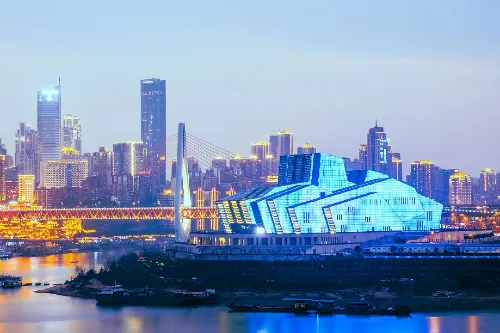

Qiansimen Jialing River Bridge
Connecting Yuzhong District and Jiangbei District, the Qiansimen Jialing River Bridge is an indispensable bridge landscape during the Two-River Tour. The main bridge is 878 meters long, with a main span of 312 meters and a deck width of 36.2 meters. The upper layer is used for urban roads, and the lower layer is for the rail transit Line 6. The design of the bridge incorporates the mountain and river characteristics of Chongqing. The bridge tower adopts a single-pylon cable-stayed structure, with an elegant and vivid shape, echoing the surrounding landscapes such as Hongya Cave and Chongqing Grand Theatre. At night, the lights of the bridge display different color effects over time. The lights reflected in the Jialing River form a gorgeous light belt, which has become a highly recognizable landmark in the night scenery of the two rivers and a popular shooting spot for tourists to take photos of the two rivers' scenery.
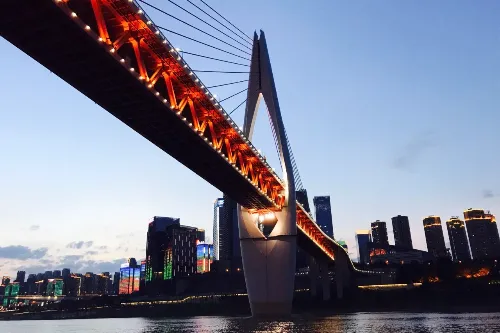
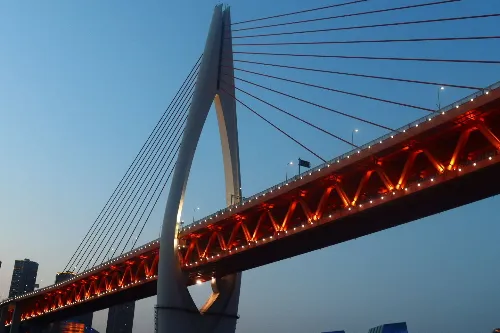

Nanbin Road Riverside Scenic Area
Located on the south bank of the Yangtze River in Nan'an District, the Nanbin Road Riverside Scenic Area is a large-scale riverside landscape belt integrating flood control and revetment, urban roads, tourism and leisure. Along the scenic area, there are many historical and cultural attractions such as the Ziyun Temple, Tanzi Stone Old Street and Longmen Haoyue. Among them, the Tanzi Stone Old Street covers an area of about 120,000 square meters, preserving a large number of ancient buildings from the Ming and Qing Dynasties and showing the historical style of Chongqing after it was opened as a treaty port. The landscape construction of Nanbin Road takes both nature and humanity into account. A large number of green plants are planted along the road, and multiple viewing platforms and riverside parks have been built. When tourists pass by by boat, they can enjoy the scattered historical buildings and modern leisure facilities along the line. It is also an excellent place to view the night scenery of the Yuzhong Peninsula, which complements the night scenery of Yuzhong District on the opposite bank, forming a complete night scene picture of the two rivers.

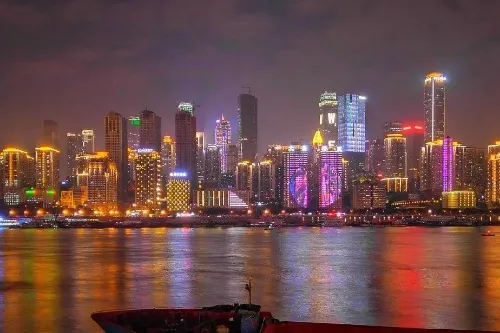
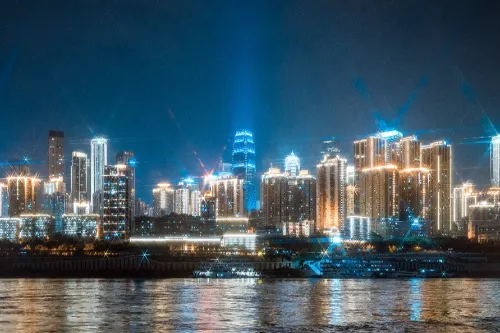
Tour Routes
There are two core routes for the Chongqing Two Rivers Cruise: the day tour and the night tour, among which the night tour is the most popular choice among tourists. The regular night tour lasts about 60 minutes and starts from Chaotianmen Wharf. The cruise ship first sails into the Jialing River, passing through scenic spots such as the Qiansimen Jialing River Bridge, Hongya Cave, Chongqing Grand Theatre and Jiangbeizui Financial City in sequence, allowing tourists to admire the splendid night scenery on both banks of the Jialing River. Then the cruise ship turns back to Chaotianmen and sails into the Yangtze River, passing by the Chaotianmen Yangtze River Bridge, Nanbin Road Riverside Scenic Area, Tanzi Stone Old Street and other landscapes before finally returning to Chaotianmen Wharf. The day tour lasts about 90 minutes. On the basis of the night tour route, it adds the section of the Yangtze River extending to the Caiyuanba Yangtze River Bridge. Tourists can observe the architectural details and natural scenery along the river more clearly, such as the mountain landforms on both banks of the Yangtze River and the ecological landscapes of the riverside parks. In addition, there is a special long-distance cruise route that lasts about 120 minutes. Departing from Chaotianmen Wharf, it sails upstream along the Yangtze River to near Jiudu Ferry in Jiulongpo District. Along the way, tourists can enjoy scenery like the Egongyan Yangtze River Bridge and the entrance to the Huangge Ancient Path. This route is suitable for tourists who have ample time and want to have an in-depth tour of the scenery along the Yangtze River.
Travel Tips
- The night tour of the two rivers is the best option. It is recommended to take the cruise ships departing between 19:30 and 21:00. During this period, the sky is completely dark and all the lights on both banks are turned on, presenting the most stunning night view. Cruise ships run most frequently at this time, with one departure every 15 to 20 minutes.
- Cruise ships are divided into regular cruises and luxury cruises. Regular cruises are more affordable in price, while luxury cruises offer value-added services such as observation decks and refreshment services. Those who pursue a better viewing experience can choose luxury cruises. It is advisable to arrive at the wharf 1 hour in advance to collect the tickets and board the ship, so as to seize the viewing spots on the second-floor deck.
- The most suitable time to visit is spring (March to May) and autumn (September to November). During these two seasons, the temperature in Chongqing ranges from 15°C to 28°C, and the wind force on the river is moderate, ensuring high comfort. Sun protection is necessary in summer as the ultraviolet rays on the river are strong. In winter, it is recommended to bring thick coats, since the wind on the river is strong at night and the temperature is 3°C to 5°C lower than that in urban areas.
- You can carry a small camera or a mobile phone during the tour. The deck is the best place for taking photos of the night scenery. It is recommended to prepare a mobile phone stabilizer to avoid blurry photos caused by the shaking of the cruise ship.
- You can learn about the historical and cultural background of the scenic spots along the route in advance. Combined with the audio commentary on the cruise ship, you can have a deeper understanding of the cultural connotation of the Two-River Tour. Some cruise ships also provide special performances such as Sichuan Opera excerpts, so you can arrange the viewing time reasonably.
Notes
- During the navigation of the cruise ship, there are many people on the deck. Please take good care of the elderly and children, and do not climb over the guardrails, which are about 1.2 meters high. Minors must be accompanied by adults when staying on the deck to prevent the risk of falling into the water.
- Carrying dangerous goods such as flammable, explosive substances and controlled knives on board is prohibited. You need to cooperate with the staff for safety inspection when boarding. Fire-fighting equipment and life-saving facilities are equipped on the cruise ship; do not move or damage them at will.
- Smoking is forbidden on the cruise ship. Catering activities shall be carried out in designated areas. Do not litter at will. Please keep the cabin and deck clean to jointly protect the ecological environment of the two rivers.
- The number of tourists surges during holidays, leading to a high demand for cruise tickets. It is suggested to book tickets through official channels 3 to 5 days in advance to avoid the situation of no tickets available on site or long waiting queues.
- In case of severe weather such as heavy rain and strong winds, the cruise ship may be temporarily suspended or the route may be adjusted. Before departure, you can call the scenic spot's consultation hotline to confirm the navigation status so as to avoid delays caused by weather. Minor jolts during navigation are normal; there is no need to panic and just follow the instructions of the staff.
Transportation
- Bus: You can take multiple bus routes including No. 112, No. 120, No. 141, No. 372 and No. 414 to directly reach Chaotianmen Wharf Station. After getting off the bus, you only need to walk about 50 to 100 meters to reach each cruise boarding gate. To get to the viewing platforms along Nanbin Road, you can take buses such as No. 338, No. 354 and No. 375 and get off at Nanbin Road Bell Tower Station.
- Rail Transit: Take Rail Transit Line 1 to Xiaoshizi Station, exit from Exit 8 and walk about 1.2 kilometers to Chaotianmen Wharf. Alternatively, take Rail Transit Line 6 to Grand Theatre Station, exit and walk about 800 meters to the riverside viewing area at Jiangbeizui. You can also transfer to a ferry here to go to Chaotianmen Wharf on the opposite bank.
- Self-driving: Self-driving tourists can navigate to "Chaotianmen Square Parking Lot", which has about 800 parking spaces. The parking fee standard for small vehicles is 10 yuan for 2 hours, and an additional 3 yuan will be charged for each extra hour. The parking pressure is relatively heavy during holidays, so it is recommended to travel during off-peak hours.
- Ferry: You can take a ferry from Tanzi Stone Wharf to Chaotianmen Wharf. The ferry fare is 2 yuan per person, and the voyage takes about 10 minutes. It is a distinctive transportation method to reach the boarding point, allowing you to experience water transportation and enjoy the river view in advance.
Opening Hours
The Chongqing Two Rivers Cruise operates in two time periods: day tour and night tour, and is open all year round except in case of special severe weather. The day tour runs from 10:00 to 16:00, with one departure every 2 hours. The night tour is from 19:00 to 22:00, and the peak departure period is between 19:30 and 21:00, with a cruise ship leaving every 15 to 20 minutes. Due to the longer days and shorter nights in summer, the night tour starts earlier at 18:30; while in winter, it starts later at 19:00. During major holidays such as the Spring Festival and National Day, additional early and late cruises will be arranged according to the number of tourists, and the departure time of the last cruise can be extended to 22:30. The specific departure time is subject to the announcement of the wharf on the day.
Ticket Information
The ticket price starts from 58 yuan per person for the day tour and 95 yuan per person for the night tour. You can search for the official WeChat service account "重庆交运两江游" to get the latest updates or buy tickets online.
Online Booking
Click here to jump to the Trip.com ticketing platform for ticket purchase.